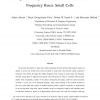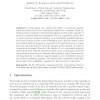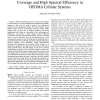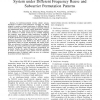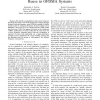196
Voted
WD
2010
14 years 7 months ago
2010
Abstract--OFDMA based cellular radio networks aim to operate as close as possible to frequency reuse distance of one, where the whole spectrum would be available in every cell. Mod...
110
Voted
EJASP
2011
14 years 7 months ago
2011
We develop and analyze a space time coded cooperative diversity protocol that achieves improved quality of service for mobile users in the downlink of small cells. The protocol, c...
123
Voted
ADHOCNOW
2008
Springer
15 years 1 months ago
2008
Springer
In this paper, we consider the effects on network capacity when the nodes of an ad hoc network are allowed to cooperate. These results are then compared to the theoretical upper b...
101
click to vote
GLOBECOM
2009
IEEE
15 years 4 months ago
2009
IEEE
Abstract--Current multibeam satellite systems perform centralized power and carrier allocation assuming a Multi-Frequency Time Division Multiple Access (MF-TDMA) scheme with fixed ...
121
Voted
WCNC
2010
IEEE
15 years 4 months ago
2010
IEEE
—Inter-cell interference (ICI) is always a big obstacle to attain wide area coverage and high spectral efficiency in cellular systems. In this work we make a study of two well-kn...
112
click to vote
ICC
2007
IEEE
15 years 7 months ago
2007
IEEE
— In interference-limited wireless cellular systems, interference avoidance and interference averaging are widely adopted to combat co-channel interference. In different types of...
92
Voted
ICC
2007
IEEE
15 years 7 months ago
2007
IEEE
Abstract— Frequency planning is a common intercell interference (ICI) management strategy in narrowband cellular networks. In this paper, we consider an alternative approach that...
VTC
2008
IEEE
15 years 7 months ago
2008
IEEE
—In this paper, we evaluate the performance of a WiMAX network in different frequency reuse scenarios with and without adaptive beaforming technique. We study the possibility of ...
109
click to vote
INFOCOM
2008
IEEE
15 years 7 months ago
2008
IEEE
—We describe an algorithm for sub-carrier and power allocation that achieves out-of-cell interference avoidance through dynamic fractional frequency reuse (FFR) in downlink of ce...

